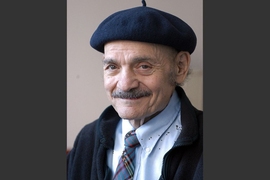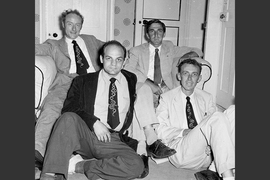Alexander Rich, an MIT biophysicist best known for his work on the structural biology of RNA and DNA, died Monday at Massachusetts General Hospital in Boston. He was 90.
Rich, the William Thompson Sedgwick Professor in MIT’s Department of Biology, continued coming in to his office until two months ago, when he was admitted to the hospital.
A pre-eminent researcher in structural molecular biology — a field that seeks to understand the molecular architecture of living organisms — Rich made major contributions to understanding the relationships between the structures and functions of RNA and DNA molecules.
James Watson and Francis Crick first described the right-handed, double helical structure of DNA in 1953. In 1979, Rich led a team of MIT researchers who startled the world of structural biology with the announcement that they had found a “left-handed” form of DNA. The new form, coiled in the shape of a left-handed screw, was called Z-DNA because of its zigzag backbone, but its significance remained a mystery for many years.
“After the initial discovery, many labs set out to understand the biology of Z-DNA, which turned out to be a much more difficult endeavor than discovering the structure in the first place,” says Thomas Schwartz, an associate professor of biology at MIT who was a PhD student of Rich’s and helped decipher the function of Z-DNA. “While we still do not fully understand its biological role, the work on Z-DNA emphasized perhaps more than any other single piece of data how important the three-dimensional conformation of DNA in the context of the cell is.”
In 1995, researchers led by Rich reported the first biological role for left-handed Z-DNA and detailed the identification of a protein that binds tightly to Z-DNA. The protein has long been recognized as an “editor” that can change the genetic message of RNA. Its affinity for Z-DNA may help it find genes that are producing the messenger RNA that it edits.
Deciphering biological structures
Rich’s pioneering work started in 1955 when, together with a colleague, he deduced the three-dimensional, triple helical structure of collagen, the major fibrous protein of skin and connective tissue.
One year later, as a section chief in physical chemistry at the National Institutes of Health, he and a colleague discovered that two single-stranded nucleic acid molecules could spontaneously and specifically combine to form a double helix. This was the first hybridization reaction, a reaction that in various forms became a major technique in the development of molecular biology. In 1957, his group discovered that nucleic acids could form triple helices, a finding widely used in biotechnology today.
At MIT in 1960, Rich discovered that an RNA strand and a DNA strand could form a double helix, which helped explain how cells copy DNA into messenger RNA.
He led student researchers in 1962 to the discovery of polysomes, the clusters of protein synthesis machinery held together by a messenger RNA molecule. These are the functional units used by cells to translate genetic information into proteins.
Born in Hartford, Conn., in 1924, Rich served with the U.S. Navy from 1943 to 1946. He received a bachelor’s in biochemical sciences from Harvard University in 1947, and graduated from Harvard Medical School in 1949.
From 1949 to 1954 he was a research fellow in chemistry with Linus Pauling at Gates and Crellin Laboratories at Caltech. He served as chief of the section on physical chemistry at the National Institute of Mental Health from 1954 to 1958, and was a visiting scientist at the Cavendish Laboratory in Cambridge, England, from 1955 to 1956. From 1969 to 1980, Rich was an investigator in NASA’s Viking mission to Mars, working on experiments designed to look for life on that planet.
He joined the MIT faculty in 1958, and mentored generations of students.
“Alex was a bright beacon and a good mentor,” says Shuguang Zhang, a principal research scientist at MIT’s Center for Bits and Atoms who worked closely with Rich. “The most important thing Alex taught us is open-mindedness. Open-mindedness opened a new world for each one of us.”
“Alex was an inspirational scientist,” Schwartz adds. “Always keen on solving the next scientific puzzle, always keen on figuring out the latest technology to move forward. His curiosity was second to none.”
High honors
In 1995, Rich received the National Medal of Science, the highest scientific honor bestowed by the U.S. government. His many other awards and honors include election to the National Academy of Sciences, the Philosophical Society, the French Academy of Sciences, the Russian Academy of Sciences, and the Pontifical Academy of Sciences. Rich was also a fellow of the American Association for the Advancement of Science and, in 1976, was appointed by President Gerald Ford to a six-year term on the U.S. National Science Board.
In 1980, Rich was presented with MIT’s James R. Killian Jr. Faculty Achievement Award, given for extraordinary professional accomplishments by faculty members. He won the $250,000 Bower Award for Achievement in Science in 2000, was presented with Sigma Xi’s William Procter Prize for Academic Achievement in 2001, and was awarded the Lomonosov Large Gold Medal from the Russian Academy of Sciences in 2002. In 2008 he was named the 38th recipient of the $300,000 Welch Award in Chemistry.
He received several honorary degrees, as well as the Rosenstiel Award in Basic Biomedical Research and the Presidential Award of the New York Academy of Sciences.
Rich is survived by his wife, Jane; two sons, Josiah and Benjamin; two daughters, Jessica and Rebecca; and seven grandchildren: Abigail, Rachel, Abraham, Nola, Nicholas, Cyrus, and Zachary.
A memorial gathering will be held on Sunday, May 3, at the Norton Woods Conference Center, 200 Beacon St., Somerville, Mass., from 1-5 p.m.











